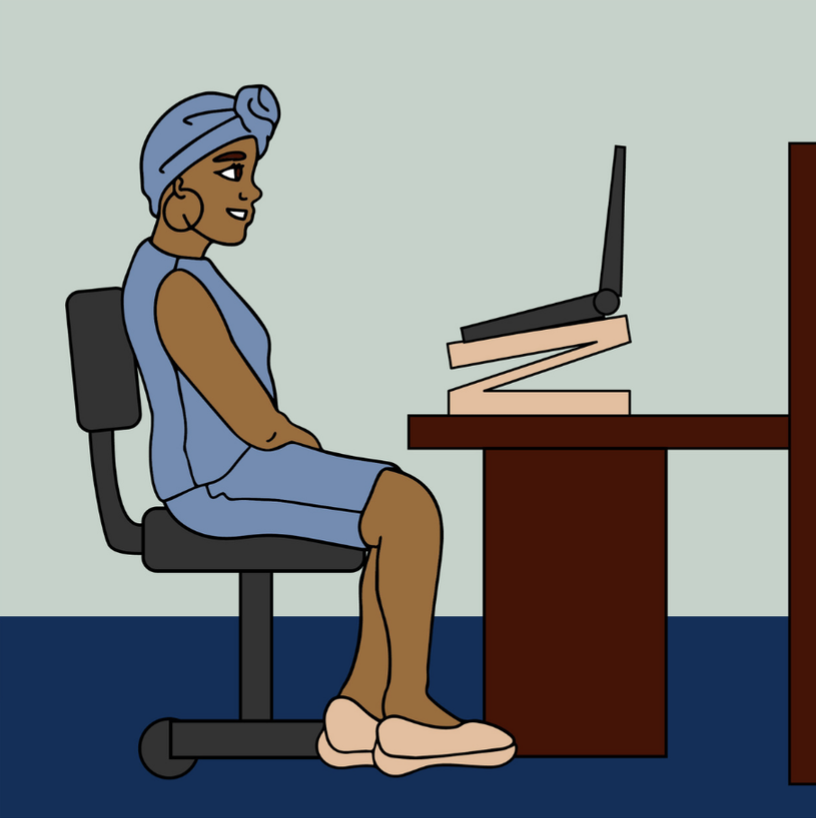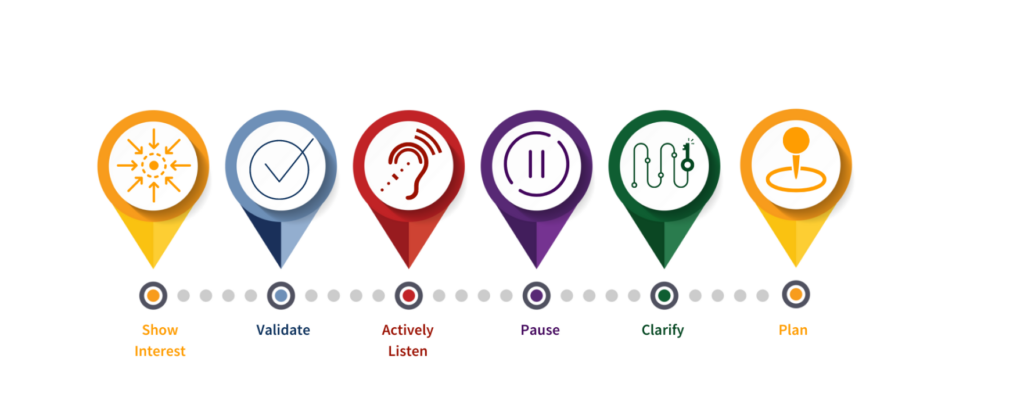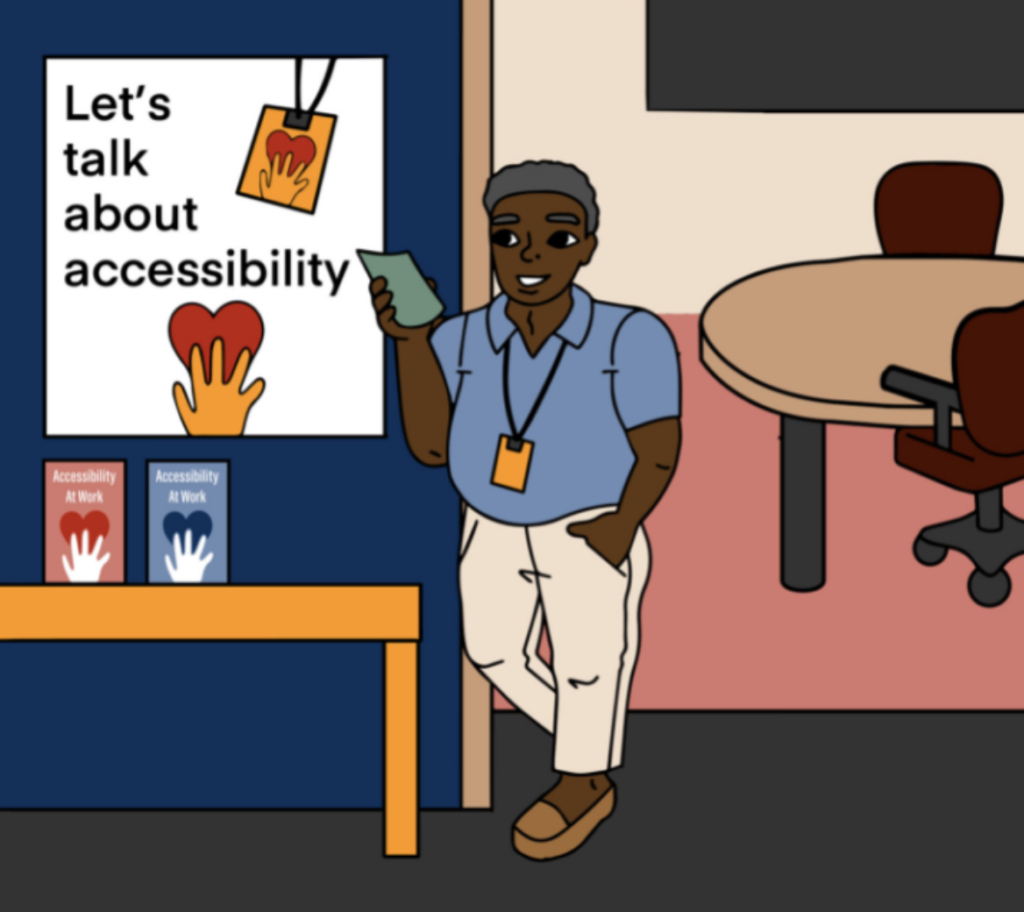Understanding Workplace Accommodations
Disclaimer: This is a free resource created by community and is not for sale. All tools, contents and resources are not to be sold.
Who is this for?
High priority: Direct Managers
Practical information: Corporate Cross-Departmental Managers
Useful to know: HR Professionals
What guidance does it provide?
Understanding the duty to accommodate and the duty to inquire
Take home points
Accommodation is as much about organizational culture and trust as it is about the policies that are created and the legal rules that are in place. An open and accepting culture towards accommodation will increase inclusion and reduce conflict during the accommodation process
Employers have a legal duty to accommodate. This duty ensures that individuals requiring accommodation are not unfairly excluded where working conditions can be adjusted
A lesser-known legal obligation that has been very clearly established in Canadian case law is the duty to inquire. The duty to inquire exists when an employer is either made aware of or perceives that a worker may need an accommodation – even if they have not outrightly asked for one.
By adopting a yes by default approach and asking all employees “what do you need” is a fundamental change in workplace culture. A “yes” approach prioritizes the processing of solutions for accommodation for all employees, including those with disabilities without the time-consuming and quality of current adjustment processes.
What Are Workplace Accommodations?
The Government of Canada1 defines a workplace accommodation as:
- Workplace accommodations involve the adaptation of work duties or the working environment, to enable all employees to fully participate in employment.
Rooted in collaboration between the employer and the worker, proper workplace accommodations can lift workplace barriers[1] and allow persons with disabilities equal access to new job opportunities, support the retention of meaningful work, or facilitate the return to work if a person has been absent because of their disability.
[1] A barrier means anything — including anything physical, architectural, technological, or attitudinal, anything that is based on information or communications or anything that is the result of a policy or a practice — that hinders the full and equal participation in society of persons with an impairment, including a physical, mental, intellectual, cognitive, learning, communication or sensory impairment or a functional limitation (Accessible Canada Act, 2019).
Exploring Types of Accommodations
Who is this for?
High priority:
Direct managers
Corporate cross-departmental managers
Direct managers
HR Professionals
What guidance does it provide?
Understanding different types of accommodations that can be provided to workers with disabilities
Practical suggestions for how to implement accommodations for specific needs
Take home points
There are 3 common categorizations for types of accommodation: flexible work arrangements, workstation modifications, and human and/or technical support
If your worker requests an accommodation, you should engage in a collaborative process to co-determine what accommodation solutions may be implemented to support them in the workplace:
- Assess stressors related to psychological, emotional, cognitive, and physical issues at work
- Develop strategies that may best support worker success
- Help maintain a safe and productive workplace
Employers and workers may start by reviewing the worker’s essential job responsibilities to both determine expectations and identify what barriers they may face when performing core tasks
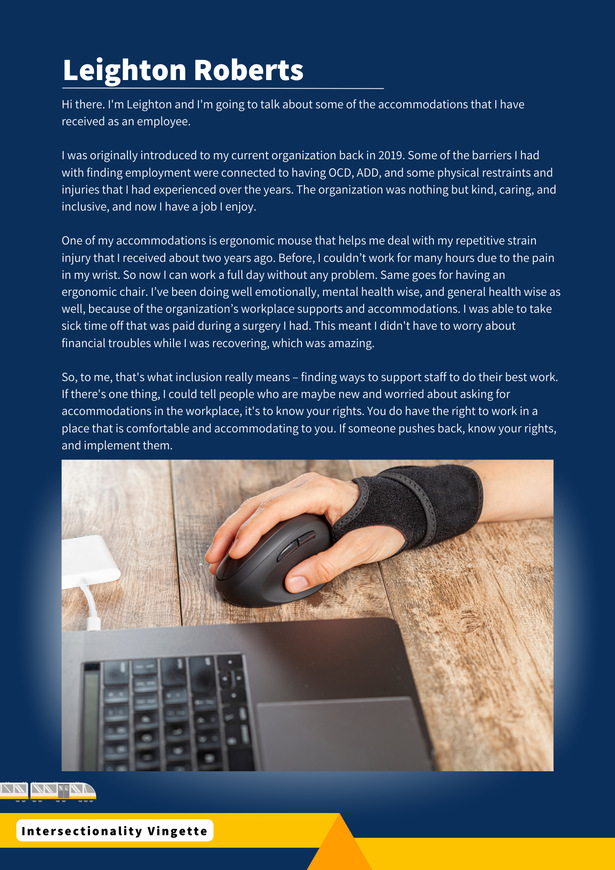
Protecting Confidentiality and Privacy
Who is this for?
High priority:
Direct managers
Corporate cross-departmental managers
Practical information:
HR Professionals
What guidance does it provide?
- How to protect and action for confidentiality and privacy in all accommodation processes for employees
Take home points
Requests for accommodation may involve disclosing private or highly sensitive information. Ask people requesting accommodation only for information required to establish the foundation of the accommodation request, and to respond appropriately to the request.
At a minimum, employers must communicate with workers what personal information will be collected, used, and disclosed. Employers should also ensure that information they collect for one purpose isn’t used for an unrelated purpose without the employee’s consent.
Impart unto all employees that accommodations are a key driver of equity in the workplace.
Sharing Responsibility with All Employees
Who is this for?
High priority:
Direct managers
Corporate cross-departmental managers
Practical information:
HR Professionals
What guidance does it provide?
- The benefits of creating a shared responsibility amongst all employees
- · How to help manage co-workers concerns about workplace change whilst respecting confidentiality
Take home points
Shared responsibility facilitates psychological wellbeing and supports performance. Both employers and employees feel responsible; they feel the organization has a collective source where all can invest their energy into to ensure its future success
Disclosure could be ongoing – colleagues will react differently depending on their working relationship with the employee with the disability. Managers need to be aware that disability inclusion and a culture of support spans much further than the first conversation about disclosure
As a manager, it is your responsibility to communicate the importance of privacy and confidentiality of personal information, such as accommodation plans and disability disclosure, to all employees
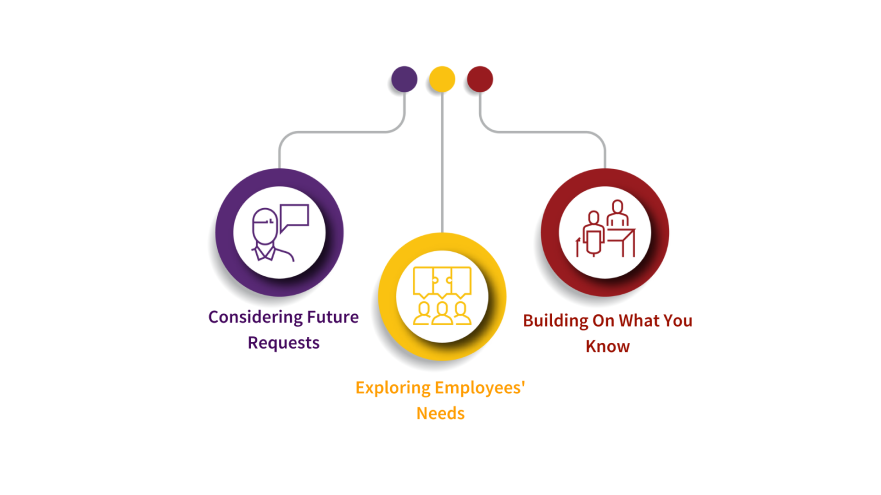
Developing Approaches to Accommodations
Who is this for?
High priority:
Direct managers
Corporate cross-departmental managers
Practical information:
HR Professionals
What guidance does it provide?
- Developing an understanding of different thought processes behind nuanced accommodation approaches
- How to develop an accommodation strategy and HR polices that best suit your organization
- Break down of 5 fundamental approaches to adopt in developing an accommodation strategy
- Access to useful, fillable checklists and relevant documents to support your accommodation process
Take home points
There is no set formula for accommodation.
Here are a few fundamental approaches to consider when creating an inclusive and accessible accommodation process and implementing change through HR policies:
Approach 1: Standardized – is a process that is simple, straightforward, and efficient. As best practice, an employer and an employee with a disability should work together to determine and implement appropriate accommodation measures
Approach 2: De-medicalized – This approach means they will not ask for medical ‘proof’ of a disability. It also reflects an understanding of disability through the social model of disability, where societal barriers are what cause the experience of disability.
Approach 3: Individualized – Employers may be tempted to assume that if one accommodation works for a person with a specific type of disability, the accommodation will be suitable for a different worker with the same disability. However, two employees with the same disability may have very different needs. The way that workers experience disability differently calls for a flexible and individualized approach to accommodations.
Approach 4: Proactive – Accessibility means that an organization has taken steps to ensure that everyone, no matter what their background, language, disability, or personal needs, can feel comfortable in the workspace and productively engage in the services.
Approach 5: Responsive – This approach should be used adjacent to all approaches in the accommodation process. The best practice is to address an employee’s needs as quickly as possible.

Breaking Down the Accommodation Process
Who is this for?
High priority:
Direct managers
Corporate cross-departmental managers
What guidance does it provide?
- If you are a manager looking to accommodate a worker with a disability, follow the 5 steps recommended to ensure that the accommodation is accessible to all
- How to ensure the provision of assistive technology in the accommodation process is inclusive and accessible
Take home points
- Workplace accommodations are modifications made at any stage of the employment journey that enable all workers to fully participate in employment.
- While accommodation in most cases is straightforward and simple, it can sometimes be a lengthy and complex process. In any case, it is important that the accommodation process be effective and respect the dignity of accommodation seekers.
- Assistive technology is essentially a service that directly assists an individual with a disability in the selection, acquisition, or use of an assistive device.
- Even before a request for an accommodation is received, an employer must inform all employees and job applicants that accommodation measures are available within the organization.
Guidance from the Canadian
Human Rights Commission
Navigating return to work cases can be challenging. It requires a fine balance between an employer’s right to manager an effective organization, with a worker’s basic rights to accessibility, privacy, equity, and dignity in the workplace. As a manager, you may feel uncertain or unsure about how to support an employee who is returning to work – especially when there are new requests for accommodations. The Canadian Human Rights Commission has developed a step-by-step procedure to support your approach and decisions around return to work:1
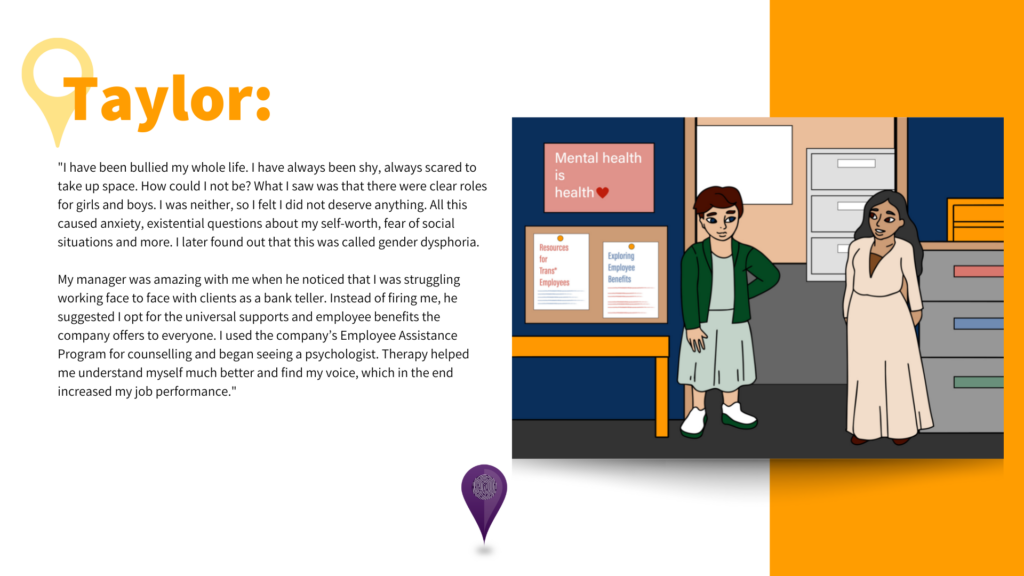
Managing Employees Returning-to-Work
Who is this for?
High priority:
Direct managers
Corporate cross-departmental managers
What guidance does it provide?
- · How to effectively implement an accessible and inclusive return to work plan
Take home points
- Workplace accommodations are modifications made at any stage of the employment journey that enable all workers to fully participate in employment.
- While accommodation in most cases is straightforward and simple, it can sometimes be a lengthy and complex process. In any case, it is important that the accommodation process be effective and respect the dignity of accommodation seekers.
- Assistive technology is essentially a service that directly assists an individual with a disability in the selection, acquisition, or use of an assistive device.
- Even before a request for an accommodation is received, an employer must inform all employees and job applicants that accommodation measures are available within the organization.
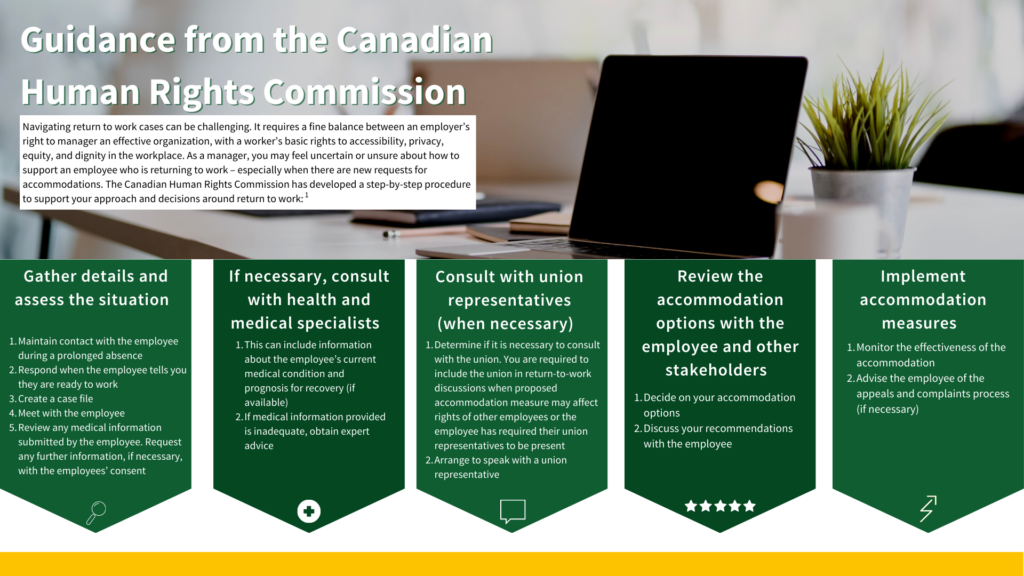
A Closer Look at Assistive Technology
Who is this for?
High priority:
Direct Managers
Practical Information:
Information Technology Professionals
What guidance does it provide?
- Information to help you understand different uses of assistive technology and how to best implement to support employees with disabilities
- Recommendations on current resources, devices, and models to accommodate employees with disabilities
Take home points
When an injury or disability can have or has consequences, a variety of processes are possible:
- Treatment
- Training
- Rehabilitation
- Vocational rehabilitation
- Medical guidance
The purpose of assistive devices is to solve users’ practical problems and they should be part of a plan. Individual plans make for a more efficient provision of assistive devices.
Please re-visit the tool to learn more on the various types of assistive devices and technologies
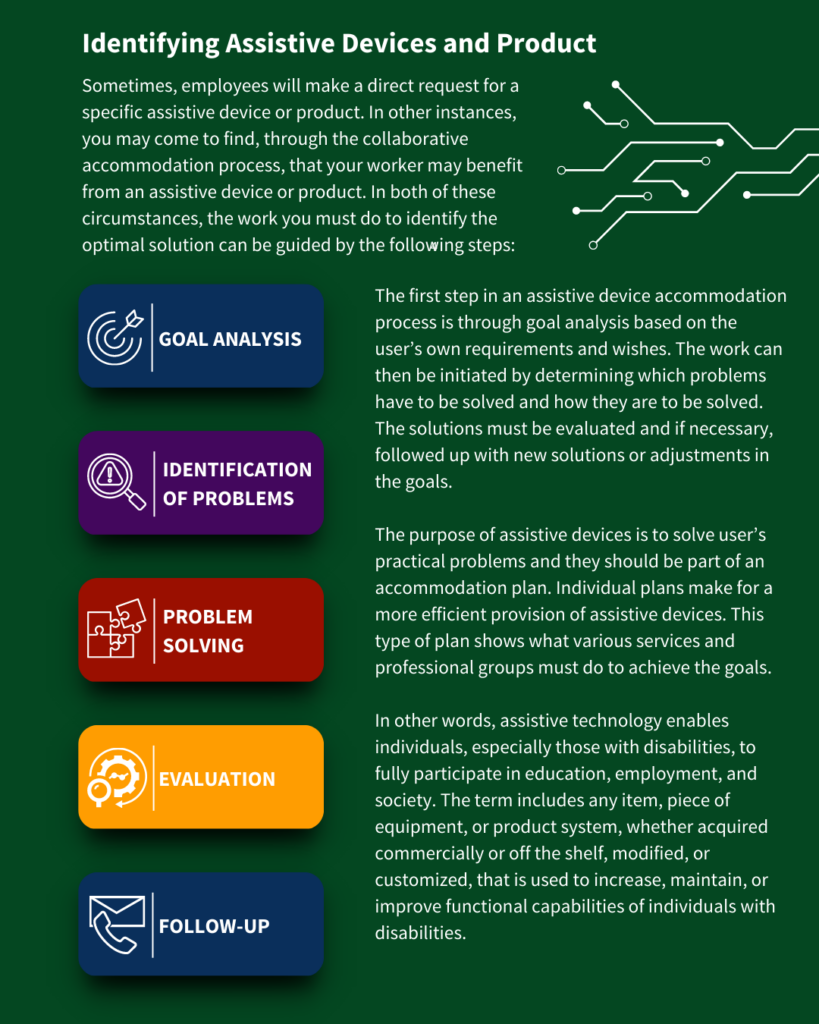
Supporting the Development of Accommodation Passports
Who is this for?
High priority:
Direct managers
Corporate cross-departmental managers
Practical information:
HR Professionals
What guidance does it provide?
- How to create and document the requirements of employees who require further accommodations within the workplace
- Guidance on best practices on negotiations, conversations, and privacy
Take home points
- Accommodation passports are dynamic, confidential documents agreed-upon between an employee and their manager about changes to work, with a built-in review period to ensure they reflect the current situation for the employee in the workplace
- By adopting a ‘yes by default’ approach and asking all employees what they need, you create a fundamental change in workplace culture. The goal is to always support everyone’s needs.
- An employee’s decision to talk to their direct manager about the passport should always be treated sensitively and respectfully.
- At their own discretion, someone with a passport can share it with anyone they think needs to know about the barriers they face and the accommodations they need.
Learning From Promising Practices in the Accommodation Space
Who is this for?
High priority:
HR Professionals
IT Professionals
Practical information:
Health and Safety Facilities
What guidance does it provide?
- Outlines promising practices to ensure accommodation processes and policies go above and beyond in supporting all employees
- Recommends resources and other sources of information to expand knowledge base
Take home points
- Centralized accommodation programs can provide both a standardized accommodation process and a centralized accommodation fund. By adopting this practice, business can deliver consistent, streamlined accommodations quickly to address their employee’s needs and reduce cost concerns
- Partnering with local providers such as Accommodation and Inclusion Management (AIM) can help provide direct support to develop inclusive workplace and implement workplace accommodations and adjustments
- The most requested accommodation in the workplace is assistive technology. Review TD’s assistive technology catalogue which highlights various features and capabilities of the assistive technology standards
Learning From Promising Practices in the Accommodation Space
Employers must be innovative, practical, and timely when considering accommodation options. The following Promising Practices can be used by businesses to develop accommodation HR policies that are consistent with the requirements of the Accessible Canada Act and can be adopted to your workplace.
Promising Practice 1: Creating A Centralized Accommodation Program
Employers are required by law to provide workplace accommodations. However, by going above and beyond to ensure easy and timely access to accommodations for both applicants and workers, you highlight your business’s commitment to disability confidence and workplace inclusion. You can work towards this by developing straightforward policies and processes for workplace accommodations or a centralized accommodation program. A centralized accommodation program can provide a:

Adopting a centralized accommodation program can yield several benefits:
· Delivers consistent, timely, and streamlined accommodations
· Reduces potential concerns about the costs of workplace accommodations
· Encourages employers to follow through with their legal duty to accommodate
· Establishes clear roles for important actors in the accommodation process (e.g., accommodation coordinator, individuals in IT, HR, Facilities, etc.)
· Communicates to employees that their needs are important and reduces stigma associated with workplace accommodations
The design of a centralized accommodation program is meant to be flexible.

